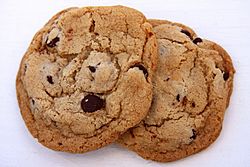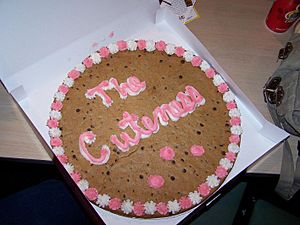Cookie facts for kids

Chocolate chip cookies
|
|
| Alternative names | Biscuit |
|---|---|
| Course | Snack, dessert |
| Place of origin | Persia, 7th century AD |
| Serving temperature | Often room temperature, although they may be served when still warm from the oven |
A cookie is a baked or cooked good that is small, flat and sweet. It usually contains flour, sugar and some type of oil or fat. It may include other ingredients such as raisins, oats, chocolate chips, nuts, etc.
In most English-speaking countries except for the US and Canada, crisp cookies are called biscuits. Chewier biscuits are sometimes called cookies even in the UK. Some cookies may also be named by their shape, such as date squares or bars.
Cookies or biscuits may be mass-produced in factories, made in small bakeries or home-made. Biscuit or cookie variants include sandwich biscuits, such as Custard creams, Jammie Dodgers, Bourbons and Oreos, with marshmallow or jam filling and sometimes dipped in chocolate or another sweet coating. Cookies are often served with beverages such as milk, coffee or tea. Factory-made cookies are sold in grocery stores, convenience stores and vending machines. Fresh-baked cookies are sold at bakeries and coffeehouses, with the latter ranging from small business-sized establishments to multinational corporations such as Starbucks.
Contents
Description

Most cookies are flat and round like a disc. Cookies often have flavors added to them, like spices, chocolate, butter, peanut butter, nuts or dried fruits. Most cookies are very sweet.
Cookies are most commonly baked until crisp or just long enough that they remain soft, but some kinds of cookies are not baked at all. Cookies are made in a wide variety of styles, using an array of ingredients including sugars, spices, chocolate, butter, peanut butter, nuts, or dried fruits. The softness of the cookie may depend on how long it is baked.
A general theory of cookies may be formulated this way. Despite its descent from cakes and other sweetened breads, the cookie in almost all its forms has abandoned water as a medium for cohesion. Water in cakes serves to make the base (in the case of cakes called "batter") as thin as possible, which allows the bubbles – responsible for a cake's fluffiness – to better form. In the cookie, the agent of cohesion has become some form of oil. Oils, whether they be in the form of butter, vegetable oils, or lard, are much more viscous than water and evaporate freely at a much higher temperature than water. Thus a cake made with butter or eggs instead of water is far denser after removal from the oven.
Oils in baked cakes do not behave as soda tends to in the finished result. Rather than evaporating and thickening the mixture, they remain, saturating the bubbles of escaped gases from what little water there might have been in the eggs, if added, and the carbon dioxide released by heating the baking powder. This saturation produces the most texturally attractive feature of the cookie, and indeed all fried foods: crispness saturated with a moisture (namely oil) that does not sink into it.
Even though it is close to cakes and other sweetened breads, cookies usually do not use water for cohesion. Water in cakes makes the base (in the case of cakes called "batter") as thin as possible, which allows the bubbles to form better. Cookies do not have bubbles, so they do not need this. In cookies, some form of oil or fat is used for cohesion. Oils, like butter, egg yolks, vegetable oils or lard are much more viscous than water and evaporate freely at a much higher temperature than water. So a cake made with butter or eggs instead of water is more dense when cooked.
History
Hard wafers have been made for as long as baking existed. They were very popular because they last a long time and are not fragile, but they were normally not sweet enough to be called cookies today.
Cookies were made at first in 7th century AD Persia, just after the use of sugar became common there. They spread to Europe through the Muslim conquest of Spain. By the 14th century, they were common in all parts of Europe, and could be found anywhere from royal cuisine to street vendors.
People started to travel around the world at that time, and cookies made a good travel snack; a sweeter version of the travel cakes used throughout history. One of the most popular early cookies, which traveled very well and became known on every continent, was the jumble, a hard cookie made mostly from nuts, sweetener, and water.
Classification
Cookies are broadly classified according to how they are formed, including at least these categories:
- Bar cookies consist of batter or other ingredients that are poured or pressed into a pan (sometimes in multiple layers) and cut into cookie-sized pieces after baking. In British English, bar cookies are known as "tray bakes". Examples include brownies, fruit squares, and bars such as date squares.
- Drop cookies are made from a relatively soft dough that is dropped by spoonfuls onto the baking sheet. During baking, the mounds of dough spread and flatten. Chocolate chip cookies (Toll House cookies), oatmeal (or oatmeal raisin) cookies, and rock cakes are popular examples of drop cookies. This may also include thumbprint cookies, for which a small central depression is created with a thumb or small spoon before baking to contain a filling, such as jam or a chocolate chip. In the UK, the term "cookie" often refers only to this particular type of product.
- Filled cookies are made from a rolled cookie dough filled with a fruit or confectionery filling before baking. Hamantash are a filled cookie.
- Molded cookies are also made from a stiffer dough that is molded into balls or cookie shapes by hand before baking. Snickerdoodles and peanut butter cookies are examples of molded cookies. Some cookies, such as hermits or biscotti, are molded into large flattened loaves that are later cut into smaller cookies.
- No-bake cookies are made by mixing a filler, such as cereal or nuts, into a melted confectionery binder, shaping into cookies or bars, and allowing to cool or harden. Oatmeal clusters and Rum balls are no-bake cookies.
- Pressed cookies are made from a soft dough that is extruded from a cookie press into various decorative shapes before baking. Spritzgebäck are an example of a pressed cookie.
- Refrigerator cookies (also known as icebox cookies) are made from a stiff dough that is refrigerated to make the raw dough even stiffer before cutting and baking. The dough is typically shaped into cylinders which are sliced into round cookies before baking. Pinwheel cookies and those made by Pillsbury are representative.
- Rolled cookies are made from a stiffer dough that is rolled out and cut into shapes with a cookie cutter. Gingerbread men are an example.
- Sandwich cookies are rolled or pressed cookies that are assembled as a sandwich with a sweet filling. Fillings include marshmallow, jam, and icing. The Oreo cookie, made of two chocolate cookies with a vanilla icing filling, is an example.
Cookies also may be decorated with an icing, especially chocolate, and closely resemble a type of confectionery.
Notable varieties
- Alfajor
- Angel Wings (Chruściki)
- Anisette
- Animal cracker
- Anzac biscuit
- Berger cookie
- Berner Haselnusslebkuchen
- Biscotti
- Biscuit rose de Reims
- Black and white cookie
- Blondie
- Brownie
- Butter cookie
- Chocolate chip cookie
- Chocolate-coated graham cracker
- Chocolate-coated marshmallow treat
- Congo bar
- Digestive biscuit
- Fat rascal
- Fattigmann
- Flies graveyard
- Florentine biscuit
- Fortune cookie
- Fruit squares and bars (date, fig, lemon, raspberry, etc.)
- Ginger snap
- Gingerbread house
- Gingerbread man
- Graham cookie
- Hamentashen
- Jumble
- Kifli
- Kolach
- Koulourakia
- Krumkake
- Linzer cookie
- Macaroon
- Mexican wedding cake
- Meringue
- Nice biscuit
- Oatmeal
- Pastelito
- Peanut butter cookie
- Pepparkakor
- Pfeffernüsse
- Pizzelle
- Polvorón
- Qurabiya
- Rainbow cookie
- Ranger Cookie
- Riposteria
- Rosette
- Rum ball
- Rusk
- Russian tea cake
- Rock cake
- Sablé
- Sandbakelse
- Şekerpare
- Shortbread
- Snickerdoodle
- Speculoos
- Springerle
- Spritzgebäck (Spritz)
- Stroopwafel
- Sugar cookie
- Tea biscuit
- Toruń gingerbread
- Tuile
- Wafer
- Windmill cookie
Related pages
Images for kids
-
A dish of assorted cookies, including sandwich cookies filled with jam.
-
Cookies baking in an oven.
-
Bakarkhani cookie is part of Mughlai cuisine of the Indian subcontinent.
See also
 In Spanish: Pastas secas para niños
In Spanish: Pastas secas para niños










